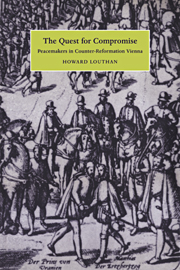Book contents
- Frontmatter
- Contents
- List of illustrations
- Acknowledgments
- A political and cultural chronology
- List of abbreviations
- Introduction
- PART I THE EMERGENCE OF AN IRENIC COURT
- 1 From confrontation to conciliation: the conversion of Lazarus von Schwendi
- 2 Jacopo Strada and the transformation of the imperial court
- PART II MAXIMILIAN II AND THE HIGH POINT OF IRENICISM
- PART III THE FAILURE OF IRENICISM
- Conclusion: Storm clouds on the horizon: from the great milk war to the Thirty Years War
- Epilogue: The wider circle of irenicism
- Select bibliography
- Index
- CAMBRIDGE STUDIES IN EARLY MODERN HISTORY
2 - Jacopo Strada and the transformation of the imperial court
Published online by Cambridge University Press: 03 December 2009
- Frontmatter
- Contents
- List of illustrations
- Acknowledgments
- A political and cultural chronology
- List of abbreviations
- Introduction
- PART I THE EMERGENCE OF AN IRENIC COURT
- 1 From confrontation to conciliation: the conversion of Lazarus von Schwendi
- 2 Jacopo Strada and the transformation of the imperial court
- PART II MAXIMILIAN II AND THE HIGH POINT OF IRENICISM
- PART III THE FAILURE OF IRENICISM
- Conclusion: Storm clouds on the horizon: from the great milk war to the Thirty Years War
- Epilogue: The wider circle of irenicism
- Select bibliography
- Index
- CAMBRIDGE STUDIES IN EARLY MODERN HISTORY
Summary
Austrian irenicism grew and flourished in a courtly environment. The evolution of the early modern court is a complicated theme, one which would lead us far afield, but a few general comments should be made to help place developments in Habsburg Vienna in their proper perspective. In early modern Europe the sovereign's court was not simply the governmental center of a specific state. It was a forum where the ruling class and intellectual elite gathered and exchanged ideas often provoking a spirited debate concerning contemporary values. The cosmopolitan lifestyle of the court frequently clashed with the provincialism and parochialism of the hinterland. Worldliness competed with piety, and the city vied with the countryside. The court was also a political institution. Here its significance must not be underestimated. In its protocol and ritual it reflected the dynastic image and served a propagandistic end by expressing the power and pretensions of the territorial ruler.
In this respect the role of the arts is most important. The atmosphere of the court was carefully controlled to portray the sovereign in the best possible light. The courts of the seventeenth century offer the finest examples of the prince's permanent pageant. In France artists and architects were essential for Louis XIV and his projection of majesty. Anthony Van Dyck and Inigo Jones helped transform the court of Charles I in England, and in Madrid the Buen Retiro and the work of Velázquez were an essential part of the ceremonial trappings surrounding Philip IV The artist helped formulate and articulate the Weltanschauung of his patron.
- Type
- Chapter
- Information
- The Quest for CompromisePeacemakers in Counter-Reformation Vienna, pp. 24 - 46Publisher: Cambridge University PressPrint publication year: 1997



